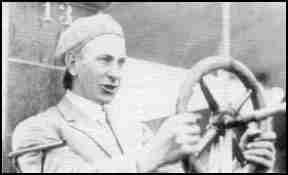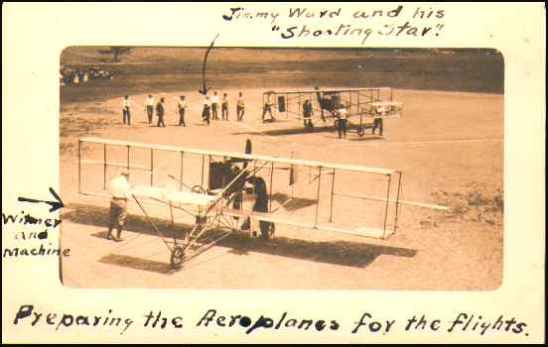
1882-1929 AKA Charles Christian Witmer |
 |
US Naval Historical Center, collections of T.G. Ellyson and J. L. Callan From WALDO: Pioneer Aviator |
Witmer later flew with the Curtiss Exhibition Team, and also spent a couple of years in Russia accompanied by Hugh Robinson with George Hallett as mechanician. They demonstrated the hydroaeroplane at Sevastopol in 1912 before the Grand Duke Alexander Michaelovitch, president of the Aerial League and a member of the Imperial Aero Club of Russia. The Czar's Navy then purchased several, and by 1914 over half of Russian aircraft were Curtiss. Witmer's own aviation career continued for many more years. |
 |
|
courtesy Bob Flippen of Southside Virginia Historical Press in Farmville, VA, 2-17-06 |
Most of the pilots who had taken up the practice of flying over water were on the entry list - a total of fifteen names. John B. R. Verplanck, an affluent sportsman from the Hudson River Valley, and his seasoned pilot, Beckwith Havens, entered a Curtiss flying boat with a 90-hp Curtiss motor, as did Charles C. Witmer, Jack Vilas, G.M. Hecksher, and Navy Lieutenant John H. Towers, Antony Jannus, Hugh Robinson, and Tom Benoist entered Benoist flying boats, each with a Hall-Scott motor of 100 hp. |
 Hydroplane on Biscayne Bay takes off with the Royal Palm Hotel in the background
HASF collection
Hydroplane on Biscayne Bay takes off with the Royal Palm Hotel in the background
HASF collectionREMINISCENCE OF CHARLES CHRISTIAN WITMER The School for Famous Flyers: BY LINDA K. WILLIAMS |
|
In the winter of 1912, just a few months after aviator Howard Gill introduced flight to South Florida, the first
"hydroplane" arrived in Miami. Hydroplanes were early seaplanes developed bv Glenn H. Curtiss. Late in 1911 ,
Curtiss had agreed to Everest G. Sewell's request that he open a flying school in South Florida during the winter
months. Students taking the course would learn to fly and maintain both land and seaplanes. Charles C. Witmer, an experienced pilot who had previously instructed army and navy personnel, was in charge of the Curtiss Flying School. The land school was at N.W. l7th Avenue and 2Oth Street, while hydroplane instructions were given on |
Biscayne Bay near the Royal Palm Hotel where Witmer was staying. Classes began on January 12 and lasted through
April. The four graduating students were Barney Moran, Augustine Parla, W. W.Vaughan.
and Senor Martini. Witmer's
stay in Miami was brief, just a few months in 1912 and possiblv another vlsit in 1916, and he eventually settled
in Santa Barbara, California. However, a letter from Witmer to Curtiss dated July 31, 1925, enhanced with
photographs of the hydroplane, remains to show a fragment of life in Miami in 1912. After a few introductory remarks, Witmer writes. "Now about the school for famous | flyers. I am afraid that if we gave the real history of every one shown in the picture you sent me (see Photoqraph above). it would read like a hard luck story. On the left is myself, Charles Christian Witmer, etc., etc., etc. Then Barney P. Moran who never made a flight after leaving the school in Hammondsport but was a very good pilot. Then C. A. Vaughn from Virginia, who could handle the plane after his first two hops and was a good flver belofe he left the school."He was quite wealthy and upon his return home from the school his mother prevailed upon him and he gave up flying and, as far as I know, never flew again. The next chap (Beachey Lincoln) is a bird from Elmira, N.Y. Came all the way |
Contributed by Alan Magluta, 7-23-11 |
|
|
|
The Birth of Naval Aviation If time permits, I heartily recommend that you visit the homepage of the site and take advantage of the many fine photos and stories which Jack had assembled over the years. |
|
He died in 1929 Birthdate courtesy of Joe Gertler Date of death from The Early Birds of Aviation Roster of members, January 1, 1966 |
|
Recommended Further Reading: WALDO: Pioneer Aviator A Personal History of American Aviation, 1910-1944 by Waldo Dean Waterman with Jack Carpenter Arsdalen, Bosch & Co. |
|
Recommended Links: Walter E. Lees on North Island, 1915 |


|